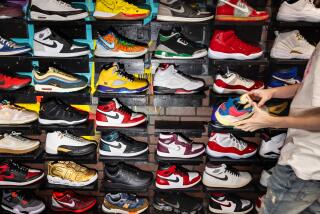Relic sellers are faking it on EBay
- Share via
When Charles “Chip” Stanish, director of UCLA’s Cotsen Institute of Archaeology, craves a good laugh over human folly, he knows it’s just a mouse-click away, on EBay’s crowded bazaar of ancient artifacts.
A reddish clay pot in the shape of a man’s head pops onto the computer screen in his office beneath the campus’ Fowler Museum. Stanish notes its wide-eyed, gape-mouthed face and tries to stifle a laugh, but there’s no helping himself. The tousle-haired anthropologist, who researches ancient commerce and communal life in the mountainous Lake Titicaca region of Peru, is slain again.
“Look at this stupid face with the stupid grin,” he says. “The teeth are ridiculous. The eyes are goofy. . . . It’s something you’d find at the Lima airport,” selling for a few bucks. On EBay, the seller is advertising it as a mint-condition artifact of Peru’s Nazca culture -- a depiction of a warrior, possibly 2,000 years old. It’s yours for $499.99, satisfaction backed with a “lifetime guarantee,” as long as that lifetime expires within the 14-day window for returns. Customers have given this seller a satisfaction rating of nearly 100%.
“Oh, I have such a good time,” Stanish says. “Sometimes I put it on my TV, and my friends and I have some glasses of wine and crack up.”
--
A measure of relief
Their laughter is intensified by a sense of relief. When antiquities began sprouting on EBay shortly after the auction website’s founding in 1995, Stanish says, archaeologists were “terrified, absolutely terrified,” that demand for ancient loot would explode, sending more and more diggers swarming over unguarded ruins. They envisioned a pastime dominated by wealthy collectors and high-end dealers suddenly proliferating with Web-based equivalents of Wal-Mart. Many more buried clues to the ancient past would vanish, researchers feared, their surroundings damaged beyond anyone’s ability to make sense of what remained.
“The great tragedy of looting is that somebody will come for one pot, and they’ll destroy an entire building or burial [site],” Stanish says. “All this cultural information is lost, for one pot.”
But a funny thing happened on the way to EBay’s boom as a new forum for very old collectibles. Stanish says that contemporary inhabitants of ancient lands soon learned that many online antiquities shoppers were, shall we say, a tad lacking in connoisseurship, not to mention in basic consumer sense.
It became apparent, he says, that people on the Net could be fooled into buying knickknacks dressed up to look plausibly ancient. Why should local diggers break their backs and risk arrest when they could stay home and make a cottage industry out of copying, with less or more verisimilitude, what their ancestors had wrought?
Stanish published his ideas in an essay in the May/June issue of Archaeology magazine, entitled “Forging Ahead, Or, How I Learned to Stop Worrying and Love eBay.”
At first, he says, archaeologists’ fears were borne out. As late as 2000, Internet sites offered “a 50-50 split” between “obvious junk and the kinds of things you have to hold in your hand and have an expert look at it, and weigh it, and smell it, and feel it, and all the things you do to authenticate these pieces. Now, 95% of the stuff you’re looking at on EBay is not real.”
What gives Stanish relief has caused headaches for Bob Dodge, founder of Artemis Gallery Ancient World Art in Lafayette, Colo. The professor’s article hits the nail on the head, Dodge says. “Anybody who knows anything avoids EBay. Fakes have been a problem in this industry since 2,000 years ago, but it’s certainly a massive problem right now, and it’s getting larger. The handful of legitimate [online] dealers, we’re just pulling our hair out, trying to discourage people from throwing money away on cheap tourist crap.”
Dodge says his business targets the “mid-range” of the antiquities market, from about $1,000 to $10,000. Now, he says, many potential buyers think he’s overpriced: “Why are we selling this piece for $1,000 when they can buy it for $50? How dare we? And once they do find they’ve been fooled, they’re going to leave the market completely. Both situations hurt my pocket.”
--
EBay responds
Usher Lieberman, an EBay spokesman, says that if fake antiquities were as rampant as Stanish claims, buyers would complain and EBay would police the problem as it does when corporations alert it that knockoffs of their brands are being sold as authentic. “We take very seriously any claims that items sold on the site aren’t genuine. . . . This isn’t something we’re hearing a lot about.”
But Stanish, Dodge and other antiquities cognoscenti say collectors rarely are willing to concede that they’ve been had. Dodge has posted a how-to buyers guide that counsels novices to study art in books and auction catalogs, and to “avoid eBay like the plague!” Written guarantees are a must, he says, preferably an unconditional, lifetime promise to refund an item if it is ever proven a fake.
Stanish doesn’t claim that EBay’s dilution as a marketplace for real ancient artifacts spells doom for the antiquities trade. But he’s hopeful that forgeries, having already fooled what he considers an “embarrassingly high” number of museums, will grow increasingly widespread and effective. Using indigenous soils and stone can defeat scientific tests used to suss out fakes, he says, and he’s betting that confusion from a proliferation of well-wrought fakes can put a real dent in the antiquities market.
However, at least one sympathetic expert has doubts. New York City archaeologist Oscar White Muscarella, author of “The Lie Became Great,” a book on forgeries from the ancient Near East, is an acerbic foe of the antiquities trade, but he doesn’t buy Stanish’s thesis that the existence of more and better fakes means less looting. “The guy who has money and a lust for antiquities is going to buy them,” Muscarella says. “What’s going to decrease plundering is not forgeries, it’s only if governments take more action.”
Jerome M. Eisenberg, an antiquities dealer since 1954, says his Royal Athena Galleries in New York is not hurting, with annual sales in the tens of millions of dollars, including an Internet trade that has “increased exponentially” over the past few years. Stanish is right about what’s happening on EBay, says Eisenberg, who also enjoys watching “just for fun” to see how people are getting fleeced. “But anybody with a decent amount of intelligence isn’t going to buy on EBay unless they know who they’re dealing with.”
He is unconcerned by all the brouhaha over museums having to repatriate looted relics, or being caught with forgeries in their collections -- Berlin’s famed bust of the Egyptian queen Nefertiti being the latest to have its authenticity challenged.
“All it does is bring people’s notice to the fact you can buy ancient art,” Eisenberg says. “All the discussion of the antiquities trade only has succeeded in making it grow.”
--
More to Read
Inside the business of entertainment
The Wide Shot brings you news, analysis and insights on everything from streaming wars to production — and what it all means for the future.
You may occasionally receive promotional content from the Los Angeles Times.











